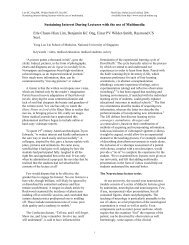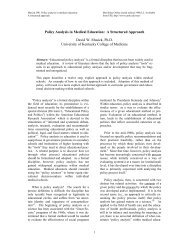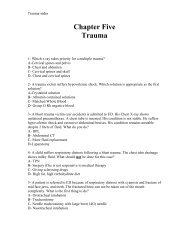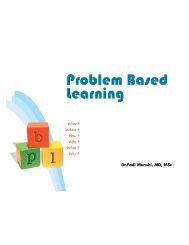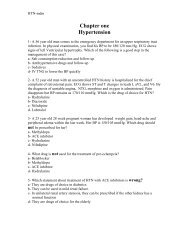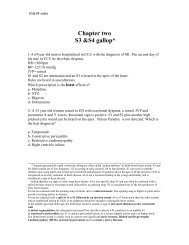Characteristics of Students Failing Medical Education: An Essay of ...
Characteristics of Students Failing Medical Education: An Essay of ...
Characteristics of Students Failing Medical Education: An Essay of ...
Create successful ePaper yourself
Turn your PDF publications into a flip-book with our unique Google optimized e-Paper software.
Mcloughlin CS. <strong>Characteristics</strong> <strong>of</strong> <strong>Students</strong> <strong>Failing</strong> <strong>Medical</strong> <strong>Education</strong>:<br />
<strong>An</strong> <strong>Essay</strong> <strong>of</strong> Reflections.<br />
Med Educ Online [serial online] 2009;14<br />
doi;10.3885/meo.2009.L0000029<br />
Available from http://www.med-ed-online.org<br />
<strong>Characteristics</strong> <strong>of</strong> <strong>Students</strong> <strong>Failing</strong> <strong>Medical</strong> <strong>Education</strong>:<br />
<strong>An</strong> <strong>Essay</strong> <strong>of</strong> Reflections<br />
Caven S. Mcloughlin, Ph.D.<br />
School <strong>of</strong> Lifespan Development and <strong>Education</strong>al Sciences<br />
Kent State University<br />
Kent, Ohio, USA<br />
Abstract: This essay <strong>of</strong>fers a series <strong>of</strong> reflections by a psychologist who has evaluated and provided<br />
remediation and counseling to medical school students who are experiencing failure despite<br />
an intellectual capacity to succeed. The common thematic indicators for students who stumble<br />
in their medical education are described. Markers for potential-to-fail are suggested that relate to<br />
students’ Information Organization, Planning Processing, and Preparation for Examinations.<br />
There can be no greater nightmare for the intending<br />
physician than the prospect <strong>of</strong> failing medical school.<br />
For students part‐way through their medical education<br />
the pressures to be successful are multiplied. Yet, quite<br />
expectedly, some find their chosen career path does not<br />
parallel their developing interests, abilities, sensitivities,<br />
or their maturing understanding <strong>of</strong> the world‐<strong>of</strong>‐work.<br />
Others, reluctantly, discover that despite their own strong<br />
interest in continuing in medicine they are no longer<br />
welcome due to academic shortcomings. A smaller proportion<br />
<strong>of</strong> the many that nonetheless do have acceptable<br />
academic standing find that because <strong>of</strong> their lifestyle, use<br />
<strong>of</strong> restricted substances, personality characteristics, or interpersonal<br />
idiosyncrasies, they are destined never to be<br />
accepted as full members <strong>of</strong> the medical fraternity.<br />
Unusually large loans support medical graduate<br />
study. The atmosphere within medical education can<br />
reflect an almost religious fervour for climbing ladders<br />
toward preferred specialties. When this scenario is intensified<br />
by a cajoling family, students have few legitimate<br />
alternatives when reappraising their initial decision to enter<br />
medical school. However, continuing is not always a<br />
decision which is theirs alone to make.<br />
<strong>Medical</strong> schools’ dismissal rates, whether or not<br />
including the number <strong>of</strong> students ‘counseled’ to discontinue,<br />
reflect an inconceivably high wastage-rate when<br />
compared to that <strong>of</strong> business, industry and commerce.<br />
This is not to suggest that medical schools intend in their<br />
selection processes to include a proportion <strong>of</strong> ‘failures’<br />
in each class. To the contrary, efforts expended in monitoring<br />
‘failure rates,’ and the reasons for the failure <strong>of</strong> a<br />
minority <strong>of</strong> students, probably outweigh in both time and<br />
effort what it would take to revise the curriculum so as to<br />
increase retention rates.<br />
There are good reasons to better understand the characteristics<br />
and functioning <strong>of</strong> the failing medical student<br />
that include earlier recognition <strong>of</strong> the student destined for<br />
difficulty. With earlier detection it might be possible to diminish<br />
unreasonable burdens on students, and rearrange<br />
environmental circumstances to promote success. Finally,<br />
with forewarning it may even be possible to counsel, tutor,<br />
motivate and otherwise ‘save’ the wastage <strong>of</strong> a massive<br />
investment (both individual and societal) through the<br />
expenditure <strong>of</strong> relatively minimal resources.<br />
The commentary in this essay will not propose a<br />
method for selecting medical students, nor will it suggest<br />
comprehensively the reasons why some students are dismissed<br />
from their medical education programs. Rather,<br />
several patterns and themes will be described which appear<br />
to characterize the learning, social, and psychological<br />
styles and dispositions <strong>of</strong> students who fail in their<br />
medical preparation programs. These are simply observations<br />
and reflections; they are unsupported by an empirical<br />
foundation and are based entirely on clinical observation.<br />
There should be no doubt that these remarks are a result<br />
<strong>of</strong> potentially idiosyncratic study <strong>of</strong> medical school students<br />
experiencing difficulty. Following the commentary<br />
will be a brief outline <strong>of</strong> some potential remediation.<br />
While not empirically based, the trends I note here<br />
are the result <strong>of</strong> data and impressions collected when interviewing,<br />
tutoring and counseling students in severe<br />
academic difficulty at a Midwestern USA medical school<br />
compiled over several years. Only those features evident<br />
in a majority <strong>of</strong> failing students are discussed. No single<br />
student reflected all the illustrated features; while each<br />
had problems, none was so burdened as to have them all.<br />
With the caveats that I have noted and an awareness that<br />
face-validity is the only measure against which these data<br />
1
Mcloughlin CS. <strong>Characteristics</strong> <strong>of</strong> <strong>Students</strong> <strong>Failing</strong> <strong>Medical</strong> <strong>Education</strong>:<br />
<strong>An</strong> <strong>Essay</strong> <strong>of</strong> Reflections.<br />
may be tested, I will first provide some reflections on basic<br />
themes characterizing students who experience difficulty<br />
attaining and maintaining academic success.<br />
Some Basic Themes<br />
It is almost never necessary to use exhaustive, diagnostic<br />
testing‐to‐limits to discern the nature <strong>of</strong> the specific<br />
problems experienced by medical students in severe<br />
difficulty. The student who is failing for apparently unaccountable<br />
reasons is rare indeed. Generally, the problems<br />
are so dramatic that the causative agents are identifiable<br />
with minimal detective work. With problems clear from<br />
the outset, the primary task is in checking that, in fact, the<br />
apparent precipitating problem is the real cause. Thus, it<br />
is generally true that presenting problems are discernible<br />
from the individual’s history; if you read for clues then the<br />
data are incontrovertible. Of course, that does not mean<br />
that the problems are simple to remediate—only that they<br />
are relatively easy to differentiate.<br />
<strong>Failing</strong> students appear to value a frank, candid appraisal.<br />
When discussing with a student the ‘clues’ that I<br />
see in their background their response is all too frequently<br />
a sincere lack <strong>of</strong> appreciation <strong>of</strong> the double-edge embedded<br />
in the evaluations they have received from Pr<strong>of</strong>essors,<br />
Clinical Directors, and their <strong>Medical</strong> School Dean.<br />
Typically the ‘clues’ implying a prospect for failure are<br />
embedded in coyly worded statements that intimate, but<br />
rarely fully-explain the depth and implication <strong>of</strong> the unsatisfactory<br />
performance. Statements that objectively and<br />
quantitatively identify a failing standard are tempered<br />
with qualitatively phrased compliments that act to diminish<br />
the impact <strong>of</strong> the intended message. Appraisals are<br />
cloaked in positive, kindly terminology; and, it is almost<br />
solely the positive upon which the student has focused.<br />
In their reading <strong>of</strong> written evaluation all they see is the<br />
encouraging tenor. Is this a case <strong>of</strong> selective attention?<br />
Almost certainly it is; however, the responsibility for accurate<br />
communication lies equally with the message-provider<br />
as it does with the recipient. It is likely that faculty<br />
concern to ensure that messages are conveyed ‘positively’<br />
in fact blunts the message’s true intent.<br />
Typically, the individual who is failing is no less<br />
committed to their success as a medical student than any<br />
peer. While highly motivated to be successful in academic<br />
study and examinations, this student rarely thinks<br />
further ahead than graduation. Only infrequently do they<br />
visualize themselves as a medical provider; rather, they<br />
are overly focused on being an acceptable medical student.<br />
Superiority, they presume, can directly be equated<br />
to a facility to remember increasingly higher mountains<br />
<strong>of</strong> facts.<br />
Med Educ Online [serial online] 2009;14<br />
doi;10.3885/meo.2009.L0000029<br />
Available from http://www.med-ed-online.org<br />
It should come as no surprise that intelligence, as<br />
measured by IQ tests and reflected in secondary education<br />
grades, is an imperfect measure for predicting success in<br />
medical education. Native ability is clearly a necessary<br />
but insufficient criterion for performing well in medical<br />
school. In fact, whereas medical students do not have to<br />
be located in the IQ stratosphere to be successful, they<br />
do have to be exceptionally well organized in their management<br />
<strong>of</strong> information. For many medical students, success<br />
has come at the expense <strong>of</strong>, and sometimes despite,<br />
grossly inefficient study habits. The existence <strong>of</strong> efficient<br />
study habits or a willingness to‘re-learn’ study systems<br />
are themselves critical indicators for identifying a candidate<br />
likely to benefit from remediation strategies.<br />
Most students who approach the stage <strong>of</strong> no‐return<br />
in medical studies say they were not particularly academically-stretched<br />
prior to entering medical school. Consequently,<br />
we should never be surprised that most approach<br />
their medical studies using the exact same strategies as<br />
they used (albeit successfully) in secondary education<br />
settings. That is, they generally practice a strategy <strong>of</strong><br />
‘when in doubt simply read, read and read again.’<br />
The failing student rarely expected to fail. This novel<br />
experience <strong>of</strong> failing is emotionally painful and <strong>of</strong>ten<br />
without precedent for the medical school failure. Consequently,<br />
it is common to see avoidance <strong>of</strong> contact with<br />
peers, and a parallel demeanour toward the school’s academic<br />
review and promotions process. <strong>Failing</strong> students<br />
have a generalized reluctance to approach appropriate<br />
academic personnel for advisement—despite their clear<br />
recognition <strong>of</strong> its importance. The feeling <strong>of</strong> abandonment,<br />
experienced by many failing medical students,<br />
causes some to drop out completely from all study related<br />
activity, which further compounds their difficulties.<br />
The failing-group includes a disproportionate number<br />
<strong>of</strong> individuals from vulnerable social situations, and a<br />
high proportion <strong>of</strong> persons living fringe-lifestyles. They<br />
appear overly represented by women and racial minority<br />
individuals, non‐traditional students in terms <strong>of</strong> age<br />
and background preparation, those in socially demanding<br />
family arrangements, people without a ready social<br />
resource system, individuals lacking a family-legacy in<br />
medicine, and those living with non‐medical roommates.<br />
Since an active social and academic resource system<br />
is more typical for those who experience success, then<br />
there is no surprise that the failing group includes many<br />
loners. While not flattering, I have heard many students<br />
in marked academic difficulty portray themselves as ‘socially<br />
retarded.’ Almost universally these are also individuals<br />
who are not part <strong>of</strong> any organized study group<br />
2
Mcloughlin CS. <strong>Characteristics</strong> <strong>of</strong> <strong>Students</strong> <strong>Failing</strong> <strong>Medical</strong> <strong>Education</strong>:<br />
<strong>An</strong> <strong>Essay</strong> <strong>of</strong> Reflections.<br />
system. They rarely can identify a ‘study-buddy.’ They<br />
may have attempted to gain study-group membership but<br />
as one student explained: ‘When I pulled myself together<br />
enough to ask, I was given too hard a task. It was intended<br />
to dissuade me from ever asking again.’ As typically dependent<br />
rather than independent characters they seem to<br />
allow the world to act on them, rather than ‘take charge’<br />
<strong>of</strong> their life. Perhaps significantly, whatever their level <strong>of</strong><br />
unhappiness as a ‘failing’ medical student, it is usual to<br />
hear a resounding sigh <strong>of</strong> relief once the school’s academic<br />
review and promotions process makes a final decision<br />
to sever the student from the medical track.<br />
<strong>An</strong> associated social difficulty relates to the student’s<br />
severely limited horizons about the World in which they<br />
live. <strong>Failing</strong> students tend not to read newspapers, nor do<br />
they watch television news programmes or participate in<br />
discussions about current events. Invariably, they cannot<br />
recall the last poem or novel they read. In an apparent<br />
contradiction, they seem overly focused on ‘things medical’;<br />
perhaps at the cost <strong>of</strong> viewing medical problems in<br />
a similar way as the auto mechanic who sees a disabled<br />
automobile without regard to its owner.<br />
There is another class <strong>of</strong> difficulties more directly<br />
associated with efficiency and accuracy at managing academic<br />
and clinical tasks. These problems can be categorized<br />
in terms <strong>of</strong> Information Organization, Planning<br />
Processing, and Examination Preparation.<br />
A. INFORMATION ORGANIZATION<br />
Problem‐solving skills are clearly independent <strong>of</strong><br />
native intellectual ability. Usually, those students with<br />
specific disabilities in problem-solving are also fundamentally<br />
naive about the gravity that such a deficit has<br />
for success in medical practice. These are people who<br />
typically use a linear approach to trace relationships, or<br />
who are without a ‘filter’ mechanism for determining<br />
the relative ‘weight’ <strong>of</strong> chunks <strong>of</strong> information. Too frequently,<br />
the failing student does not understand the difference<br />
between central postulates and marginal detail;<br />
all ‘information’ is given equal priority. Also, they may<br />
think linearly or successively rather than use simultaneous<br />
strategies—that is, they have an inefficient cognitive<br />
route‐map to help in making judgments at critical decision<br />
points. Unfortunately, the traditional tertiary education<br />
system does little to teach problem-resolution strategies<br />
as a formal skill aimed at improving efficiency.<br />
It may help to contrast the elements <strong>of</strong> successive<br />
and simultaneous processing for adult learners, with examples<br />
<strong>of</strong> behavioural clues and observations for each<br />
approach demonstrated by medical students. It should<br />
help to keep in mind that whether successive or simultaneous<br />
in basic orientation, the student still needs to<br />
have access to a variety <strong>of</strong> efficient planning processing<br />
strategies. Clearly, the preferred processor is the student<br />
who makes use <strong>of</strong> a simultaneous approach, but who also<br />
has access to efficient planning processing strategies.<br />
Thus, conceptually, the successive/simultaneous processing<br />
style represents higher order functioning, while the<br />
specific problem management strategies (represented by<br />
planning processing) serve to make the general approach<br />
more, or less, efficient.<br />
Successive Processing: The focus is on the linear, serial<br />
relationship <strong>of</strong> ideas and information.<br />
Key points<br />
Med Educ Online [serial online] 2009;14<br />
doi;10.3885/meo.2009.L0000029<br />
Available from http://www.med-ed-online.org<br />
• Student arranges information in specific linear sequences.<br />
• Orientation <strong>of</strong> ‘parts’ into a ‘whole’ is not easily or<br />
frequently accomplished.<br />
• Each segment <strong>of</strong> a reading (or task) is related only<br />
to the next one in the sequence (i.e., the whole cannot<br />
be surveyed without recourse to considering every<br />
element <strong>of</strong> the detail in the chain-like progression <strong>of</strong><br />
information). The successive-processing student cannot<br />
‘jump’ to the central thesis.<br />
Student’s behavioural clues, and examples <strong>of</strong><br />
activities: Over‐repetition <strong>of</strong>, and emphasis on, serial<br />
events; incorrect use <strong>of</strong> syntax (or over‐rigid, uncreative<br />
reliance on semantic-clues in a reading); jerky, rather<br />
than smooth, motor movements; almost no linkage or<br />
reference to related information from alternative sources<br />
(whether medical education units, modules or courses);<br />
relative absence <strong>of</strong> strategies for ordinating ideas within<br />
a reading (e.g., few subheadings within lecture notes),<br />
and little understanding <strong>of</strong> the concept <strong>of</strong> hierarchically<br />
arranging information based on priority within that information-set.<br />
When confronted by a patient with diffuse or<br />
multiple symptoms the student fixates on a single element<br />
<strong>of</strong> the presenting symptomatology, misses crucial and ‘obvious’<br />
clues, and after‐the‐fact is sincerely unaware that<br />
the analysis was incomplete (i.e., he/she is dangerously<br />
single‐minded in symptom pursuit). The student engaged<br />
in successive processing strategies does not seek to link<br />
data by creating bridges between informational elements.<br />
When this student uses someone else’s memory device,<br />
a mnemonic for example, they invariably incorporate it<br />
without any change or modification.<br />
Observation: This problem-solving strategy results<br />
in an extremely time-consuming and inefficient approach<br />
to managing complexity. The inefficiency results from<br />
3
Mcloughlin CS. <strong>Characteristics</strong> <strong>of</strong> <strong>Students</strong> <strong>Failing</strong> <strong>Medical</strong> <strong>Education</strong>:<br />
<strong>An</strong> <strong>Essay</strong> <strong>of</strong> Reflections.<br />
the student’s need to ‘cycle‐back’ each time a higher‐order<br />
interpretation or advanced information-retrieval is<br />
demanded. The student treats information as though it<br />
originates from within encapsulated, discrete and separate<br />
entities; without regard to the possibility that linkages between<br />
otherwise apparently unrelated information might<br />
need to be sought out, or even cultivated. Essentially,<br />
the symptom-pursuit strategies are grossly and dangerously<br />
inefficient because the significance <strong>of</strong> relationships<br />
across information units is unappreciated.<br />
Simultaneous Processing: The manipulation <strong>of</strong> information<br />
through the thoughtful selection <strong>of</strong> personally<br />
relevant strategies and the imposition <strong>of</strong> ‘meaning’<br />
upon a databank <strong>of</strong> otherwise disparate facts.<br />
Key points<br />
• Requires the student to arrange information into a<br />
group or network.<br />
• Requires that the student thoroughly comprehend the<br />
information being confronted; rather than approaching<br />
it as a series <strong>of</strong> unrelated facts susceptible to being<br />
learned using rote memory devices,<br />
• Each segment <strong>of</strong> a reading (or diagnostic task) is related<br />
to every other part <strong>of</strong> that task (i.e., the whole<br />
can be surveyed as a consequence <strong>of</strong> considering the<br />
relationships within the whole). Thus, simultaneousthinking<br />
students can ‘jump’ to the central idea because<br />
they can see the relevance <strong>of</strong> each main idea to<br />
all other main and subordinate ideas.<br />
Student’s behavioral clues and examples <strong>of</strong> activities:<br />
The student using simultaneous processing strategies<br />
seeks out logical relationships between sets <strong>of</strong> information.<br />
<strong>An</strong>d, where these are not immediately evident, this<br />
student attempts to impose a personalized interpretation<br />
<strong>of</strong> meaning onto the data set. The student can perceive<br />
abstract relationships, identify higher‐order meaning, and<br />
differentiate the relative importance <strong>of</strong> ideas embedded<br />
in a complex reading (or task). The student creates several<br />
personalized strategies for manipulating information<br />
(e.g., develops personally meaningful mnemonics). Thus,<br />
when the student incorporates someone else’s mnemonic<br />
it is purposely modified to make it personally meaningful.<br />
Observations: This personalized-study-approach<br />
makes it easier for an evaluator <strong>of</strong> the student’s ‘study<br />
skills’ to assume that each stratagem is inefficient or irrelevant<br />
since the student’s approach does not reflect that<br />
<strong>of</strong> the evaluator. However, idiosyncrasy is inherent within<br />
personalizing. The true measure <strong>of</strong> the efficiency <strong>of</strong> the<br />
student’s approach is answered by the test <strong>of</strong> pragmatism:<br />
Does it work? It would be wrong to deduce that<br />
the simultaneous processing student studies effort‐free;<br />
however, the time that is expended brings more lasting<br />
results and an improved outcome when compared to the<br />
linear thinker.<br />
A rule‐<strong>of</strong>‐thumb problem solving index that I use<br />
is to ask about the student’s selection <strong>of</strong> a medical specialty.<br />
Whatever their stage in medical education this is a<br />
universal experience. It is remarkably typical for failing<br />
students to have made their initial selection—then never<br />
to have gone back to re‐evaluate that choice with updated<br />
information learned on the journey through medical<br />
school. Many times the trigger for the initial choice was<br />
itself ill‐informed (a television portrayal, someone they<br />
once knew in a particular specialty, a traditional family<br />
role, or presumed higher income prospects). Particularly<br />
frightened to evaluate their own initial decision to go to<br />
medical school are the very same students who themselves<br />
see their options for continuing as being snatched<br />
away.<br />
In this exercise I ask the failing student to tell me<br />
what data they accrued to make their current choice. Do<br />
they know the influences on their choice? I also evaluate<br />
their degree <strong>of</strong> self‐knowledge. Have they factored in<br />
their own values, needs and desires into the selection <strong>of</strong><br />
a medical specialty? Do they ever engage in self-assessment<br />
as a personal-retreat? That is, do they ever attempt<br />
an appraisal <strong>of</strong> their pr<strong>of</strong>essional and social aspirations?<br />
Typically, students in difficulty have a poor understanding<br />
<strong>of</strong> self. At the most basic level, some even appear not<br />
to know where their strengths lie in the traditional triad—<br />
people, information, and things.<br />
Efficient information‐organization involves meaningfully<br />
storing data so as to be later able to retrieve it<br />
efficiently. Most students-in-difficulty focus on retrieval,<br />
assuming that the storage mechanism will take care <strong>of</strong><br />
itself. They have forgotten (or perhaps never knew) that<br />
efficiency in storage is the primary limiter to one’s later<br />
ability to retrieve. When they do organize information,<br />
it is done idiosyncratically and exclusively according<br />
to class topic, organ system, or even the academic year<br />
when it was initially taught. Such a study-approach treats<br />
academic lecture classes as though each teaches discrete<br />
pools <strong>of</strong> medical knowledge that are unitary and ultimately<br />
separate; knowledge units are thoroughly compartmentalized.<br />
These comments also address the student’s<br />
approach to planning processing, which now will be<br />
briefly addressed.<br />
4<br />
Med Educ Online [serial online] 2009;14<br />
doi;10.3885/meo.2009.L0000029<br />
Available from http://www.med-ed-online.org
Mcloughlin CS. <strong>Characteristics</strong> <strong>of</strong> <strong>Students</strong> <strong>Failing</strong> <strong>Medical</strong> <strong>Education</strong>:<br />
<strong>An</strong> <strong>Essay</strong> <strong>of</strong> Reflections.<br />
B. PLANNING PROCESSING: How a person decides<br />
to solve problems and consequently their pr<strong>of</strong>iciency<br />
at finding resolution.<br />
Key points<br />
• Planning allows the student to regulate, modify and<br />
evaluate their activities.<br />
• Planning is a conscious, learnable activity; reflected<br />
in the strategies a person uses to pursue difficult‐to‐interpret<br />
information, and in the systems students use<br />
to codify information into their memory‐storage for<br />
later retrieval <strong>of</strong> that information.<br />
• Planning is demonstrated by the existence <strong>of</strong> a course<br />
<strong>of</strong> action for solving tasks that can be articulated by<br />
the user.<br />
• Planning allows for the inspection <strong>of</strong> the performance<br />
<strong>of</strong> strategies, so as to determine their effectiveness.<br />
• Planning is the ‘thinking person’s’ system for impulse<br />
control and the regulation <strong>of</strong> their activity patterns.<br />
Student’s behavioral clues, and examples <strong>of</strong> activities:<br />
<strong>An</strong> efficient plan-processor evidences efficient<br />
completion <strong>of</strong> tasks with clear, concise, organized notes;<br />
ordination and heading within notes is commonplace; student<br />
makes a conscious effort to differentiate unimportant<br />
from mundane or trivial information; student appears<br />
to be able to visualize relationships within pools <strong>of</strong> information,<br />
even across apparently disparate fields; student<br />
tries to impose a pattern or meaning onto the mountains<br />
<strong>of</strong> information that contemporary medical practitioners<br />
experience.<br />
Observations: <strong>Students</strong> correct, modify, or in some<br />
way fine‐tune their strategic plan whenever it leads to error,<br />
or becomes inefficient or time-consuming. This requires<br />
that the student regularly and consciously reflect<br />
upon the plan that is being used. If a student cannot, after<br />
a few moments <strong>of</strong> thought, articulate the strategy being<br />
used to solve problems then most typically that student is<br />
not using any strategy (i.e., they use true ‘trial‐and‐error’<br />
in the hope <strong>of</strong> hitting some instances <strong>of</strong> ‘trial‐and‐success’).<br />
Coding information for storage is the most vulnerable<br />
link in the three-part chain: Codify → Place-into-<br />
Memory → Retrieve<br />
C. EXAMINATION PREPARATION<br />
<strong>Students</strong> who stumble at the hurdle <strong>of</strong> formal examinations<br />
use characteristically inefficient strategies for<br />
preparation. They are not particularly test‐wise (seen, for<br />
example, in their failure to recognize that multiple-choice<br />
tests planfully embed incorrect answers as intentional distracters).<br />
These are students who fare particularly poorly<br />
when questions are not identified as originating from a<br />
particular content or subject area. Their study preparation<br />
invariably anticipates that examinations will comprise a<br />
set <strong>of</strong> separate quizzes, each <strong>of</strong> which will be exclusive<br />
to a particular domain—and labelled with that domain<br />
name. For example, if the student does not have a prompt<br />
to tell in which domain the knowledge might be located<br />
(Biochemistry, Neuro<strong>An</strong>atomy, etc.), then there is a high<br />
probability that the question will go unanswered. This<br />
student, too, has difficulty whenever information from<br />
more than one domain needs to be combined to establish<br />
a whole that is greater than the sum <strong>of</strong> the parts. This<br />
particular difficulty relates to a failure to develop an understanding<br />
<strong>of</strong> conceptual linkages between information<br />
learned across different medical topics or domains.<br />
Rarely does the failing student see the totality <strong>of</strong> the<br />
medical class’s content in any holistic sense. Their singular<br />
approach to facts is distinctive; information is deemed<br />
meaningful only in its particular, rather than universal,<br />
context. This is the very student who will later approach<br />
a case presentation in a particularistic way (for example<br />
focusing exclusively on organ failure and foregoing the<br />
‘whole‐patient’ appraisal). The student’s study-notes reflect<br />
this approach; for, material taught in each class is<br />
encapsulated—without cross referenced bridges to tie<br />
together concepts taught in linked-courses. Universally,<br />
class content is viewed as disparate and essentially unrelated,<br />
except to itself.<br />
REMEDIATION<br />
Med Educ Online [serial online] 2009;14<br />
doi;10.3885/meo.2009.L0000029<br />
Available from http://www.med-ed-online.org<br />
Procedures for providing assistance to the students<br />
described in this essay are based more in art than in science.<br />
Nonetheless and not surprisingly, the method <strong>of</strong><br />
choice relates specifically to the identified shortcomings—which<br />
itself is the medical model <strong>of</strong> targeting treatment<br />
to the ‘pathology.’<br />
Emphases are placed on multiple strategies so that<br />
the student can take charge <strong>of</strong> study preparation and management.<br />
This can mean that the student will need to be<br />
counselled in:<br />
• Systems for personal time management.<br />
• Strategies for initially organizing (rather than later<br />
retrieving) information provided in classes or clinical<br />
rotations.<br />
• Recognizing the relative importance <strong>of</strong> context within<br />
a recommended reading—which means that the<br />
student must be prepared to seek out backward‐acting<br />
and forward‐acting textual cues that illuminate<br />
essential meaning.<br />
• Considering the advantages/disadvantages <strong>of</strong> pro-<br />
5
Mcloughlin CS. <strong>Characteristics</strong> <strong>of</strong> <strong>Students</strong> <strong>Failing</strong> <strong>Medical</strong> <strong>Education</strong>:<br />
<strong>An</strong> <strong>Essay</strong> <strong>of</strong> Reflections.<br />
prietary study schools examination preparation programs.<br />
• The personalizing <strong>of</strong> the student’s responsibility for<br />
study preparation.<br />
• Recognizing the appropriateness <strong>of</strong> supplementing<br />
examination preparation through attending extra<br />
classes, taking ‘mock examinations’ or ‘shelfboards.’<br />
• Incorporating personally-relevant mnemonics and<br />
diagramming or charting information (e.g., with<br />
colour coded systems).<br />
• Developing ‘picturable notes’ so as to be able to visualize<br />
material.<br />
• Explaining traditional study strategies; for example,<br />
the Study, Question, Read, Recite, Review paradigm<br />
(SQ3R).<br />
• Developing a dictionary-habit for discovering the<br />
meaning <strong>of</strong> uncertain terms.<br />
• Searching texts for keywords, definitions, and linking<br />
concepts, and such like.<br />
Most <strong>of</strong> all is the need for students to construct meaningful<br />
linkages between information and concepts learned<br />
across different areas <strong>of</strong> medicine. This can be done by<br />
cross-referencing information and concepts learned in<br />
various courses <strong>of</strong> study, and finding multiple ‘hooks’ for<br />
single chunks <strong>of</strong> knowledge.<br />
True to scientific form, most medical students in<br />
trouble become very objective and deny their valuable<br />
subjective feelings. That is why most <strong>of</strong> these suggestions<br />
are not particularly novel. They represent fairly common<br />
sense approaches which most <strong>of</strong> us will reflect on having<br />
used at one time or another. However, common-sense is<br />
in remarkably short supply for the medical student who<br />
begins to sense failure on the horizon.<br />
Correspondence<br />
Caven S. Mcloughlin, Ph.D.<br />
Pr<strong>of</strong>essor <strong>of</strong> School Psychology<br />
School <strong>of</strong> Lifespan Development<br />
and <strong>Education</strong>al Sciences<br />
405 White Hall<br />
Kent State University<br />
Kent, Ohio 44242 USA<br />
Phone: 330-672-2928<br />
Fax: 330-672-2675<br />
E-mail: caven@kent.edu<br />
Med Educ Online [serial online] 2009;14<br />
doi;10.3885/meo.2009.L0000029<br />
Available from http://www.med-ed-online.org<br />
Material in <strong>Medical</strong> <strong>Education</strong> Online is licensed under a Creative Commons Attribution-Share Alike 3.0 United<br />
States License.<br />
6



